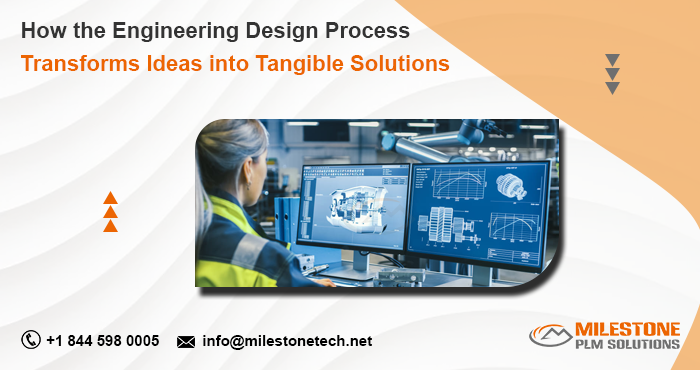How the Engineering Design Process Transforms Ideas into Tangible Solutions
Contents |
[edit] Introduction
The realm of engineering is a dynamic and ever-evolving landscape where innovation and problem-solving go hand in hand. At the heart of this process lies the Engineering Design Process, a systematic approach that converts abstract ideas into tangible solutions. In this article, we will explore the key stages of the Engineering Design Process and how it plays a pivotal role in shaping the world around us.

[edit] Understanding the Engineering Design Process
The Engineering Design Process is a series of steps that engineers follow to conceive, develop, and implement solutions to real-world problems. While the specific stages may vary, a typical process involves:
- Problem Definition: Identifying and understanding the problem at hand is the first crucial step. Engineers delve deep into the challenges, constraints, and requirements to formulate a clear problem statement.
- Research and Gathering Information: Informed decision-making is vital in engineering. Engineers conduct extensive research to gather data, explore existing solutions, and understand the technological landscape related to the problem.
- Conceptualisation and Ideation: This stage involves brainstorming and generating a variety of potential solutions. Creativity takes centrr stage as engineers explore different concepts and ideas to address the identified problem.
- Preliminary Design: Once a set of promising concepts is identified, engineers move on to the preliminary design phase. This involves sketching, prototyping, and creating initial models to visualise and assess the feasibility of each solution.
- Detailed Design: With a refined set of concepts, engineers delve into the nitty-gritty details of the chosen solution. This stage involves creating detailed plans, specifications, and blueprints that guide the actual implementation.
- Prototyping and Testing: Building prototypes allows engineers to validate their designs in a real-world setting. Testing helps identify potential flaws, refine the design further, and ensure the final solution meets the specified requirements.
- Optimisation: Continuous improvement is a key aspect of engineering. Engineers analyse test results, gather feedback, and optimise the design to enhance performance, efficiency, and overall effectiveness.
- Final Implementation: The refined design is now ready for full-scale implementation. This stage involves the construction, assembly, or deployment of the final product or solution.
[edit] The Role of Technology and AI in the Engineering Design Process
As technology advances, so does its impact on the Engineering Design Process. Artificial Intelligence (AI) tools have become integral in streamlining various stages of the process. Here's how:
- Data Analysis and Simulation:
AI algorithms can quickly analyse vast amounts of data, aiding engineers in making informed decisions. Simulation tools powered by AI enable realistic testing scenarios, helping refine designs before physical prototypes are built.
- Generative Design:
AI-driven generative design tools explore countless design possibilities based on specified parameters. This not only accelerates the conceptualisation phase but also unveils innovative solutions that human designers might not have considered.
- Predictive Maintenance:
In the detailed design and implementation stages, AI plays a role in predictive maintenance. By analysing data from sensors and monitoring systems, AI can predict potential issues, enabling proactive maintenance and minimising downtime.
[edit] Conclusion
The Engineering Design Process is a dynamic journey that transforms abstract ideas into tangible solutions. With technology and AI tools becoming increasingly integrated into this process, engineers can navigate the complexities of design, testing, and implementation more efficiently. As we embrace these advancements, the future holds exciting possibilities for engineering solutions that push the boundaries of innovation.
The MILESTONE team can assist you with Product Design, 3d Modelling, Drafting & detailing, Reverse Engineering, FEA Analysis and more. We support multiple software including AutoCAD, Solidworks, Catia, NX, Inventor, Solidedge & Ansys etc. Our approach is to provide a dedicated team for each customer over ongoing project and deliver the quality output consistently
--Engineering Design & BIM Services
[edit] Related articles on Designing Buildings
- Asset information model.
- Benefits of manufacturer-created BIM models.
- BIM dimensions.
- BIM dimensions, maturity and levels of development.
- BIM execution plan.
- BIM for dummies - an interview.
- BIM levels of development (LOD).
- Centrally procured public projects.
- Construction Operations Building Information Exchange (COBie).
- CIC BIM Protocol.
- Common data environment.
- Data drops.
- Federated building information model.
- Government Construction Strategy.
- Industry Foundation Classes.
- Information manager.
- Level 2 BIM.
- Level 3 BIM.
- Level of detail.
- Open data.
- PAS 1192-2:2013.
- PAS 1192-3:2014.
- Project information model.
- The 4 Stages of BIM Process in Construction.
- Uniclass.
Featured articles and news
CIOB report; a blueprint for SDGs and the built environment
Pairing the Sustainable Development Goals with projects.
Latest Build UK Building Safety Regime explainer published
Key elements in one short, now updated document.
UKGBC launch the UK Climate Resilience Roadmap
First guidance of its kind on direct climate impacts for the built environment and how it can adapt.
CLC Health, Safety and Wellbeing Strategy 2025
Launched by the Minister for Industry to look at fatalities on site, improving mental health and other issues.
One of the most impressive Victorian architects. Book review.
Common Assessment Standard now with building safety
New CAS update now includes mandatory building safety questions.
RTPI leader to become new CIOB Chief Executive Officer
Dr Victoria Hills MRTPI, FICE to take over after Caroline Gumble’s departure.
Social and affordable housing, a long term plan for delivery
The “Delivering a Decade of Renewal for Social and Affordable Housing” strategy sets out future path.
A change to adoptive architecture
Effects of global weather warming on architectural detailing, material choice and human interaction.
The proposed publicly owned and backed subsidiary of Homes England, to facilitate new homes.
How big is the problem and what can we do to mitigate the effects?
Overheating guidance and tools for building designers
A number of cool guides to help with the heat.
The UK's Modern Industrial Strategy: A 10 year plan
Previous consultation criticism, current key elements and general support with some persisting reservations.
Building Safety Regulator reforms
New roles, new staff and a new fast track service pave the way for a single construction regulator.
Architectural Technologist CPDs and Communications
CIAT CPD… and how you can do it!
Cooling centres and cool spaces
Managing extreme heat in cities by directing the public to places for heat stress relief and water sources.
Winter gardens: A brief history and warm variations
Extending the season with glass in different forms and terms.
Restoring Great Yarmouth's Winter Gardens
Transforming one of the least sustainable constructions imaginable.
























